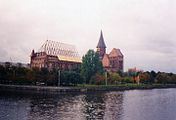West building

West building is an art-historical generic term for tower-like transverse rectangular structures at the western end of a church. This term encompasses: west works , Saxon west bar , double tower facades , west towers and other west buildings that do not fall into any of these categories.
Märkischer west building
A specific form of the church tower in the area of the German East Settlement is called Märkischer Westbau .
Ernst Badstübner describes the western buildings east of the Elbe as "box-shaped transverse structures which - placed on the western side in front of the long aisles - take the place of a tower facade, but rather resemble a house that can at best be described as tower-like." Nave ("ship's width"); in some cases (e.g. in the Uckermark ) they are not very wide.
In the Altmark and in the Brandenburg art landscape , these western buildings appear in both village and town churches and are usually made of granite blocks. The western buildings of the town churches differ from those of the village churches only in their larger dimensions and only in exceptional cases in a more differentiated shape (e.g. Marienkirche in Prenzlau ). Most of the urban examples date from the 13th century (concentrated around the middle of the century), i.e. the founding time of most of the Brandenburg cities . In village churches, western buildings still appear in the 14th to 16th centuries, but then mostly with unquared field stones or mixed masonry. Overwidth is more likely to be found in town churches than in village churches.
In Brandenburg as well as in southern Western Pomerania and in the Elbe-Havel corner of Saxony-Anhalt there are - in addition to well over 100 village churches - around 50 western buildings on parish churches of towns and market towns ( oppida ). Exceptions are the cathedral of Havelberg and the monastery church of Stolpe (unclear because monastery churches usually do not have massive west towers).
West buildings east of the Elbe are sometimes erroneously referred to as west works or west bars . Since the most important characteristic of the western works is often a princely seat , western works cannot appear on parish churches . Kingship was not present in the area of the German East Settlement . West works are therefore to the west of the Elbe-Saale line, west buildings on the other hand (unless it is the generic term) east of the Elbe. The construction of west works ends in the 11th century. The erection of western buildings (unless there is a generic term) did not occur until after the beginning of the eastern settlement (middle of the 12th century), especially in the 13th century.
Outside the Mark Brandenburg
During the Gothic period, western buildings were built in various places, which, despite the monumental façade, often only slightly towered over the nave and to which sometimes a tower, sometimes two towers, were added.
Strasbourg Cathedral : unfinished two-tower facade with a bell-shaped storey between the tower stumps converted to a west building with a horizontal closure, then a newly planned north tower (newly planned south tower not implemented)
Königsberg Cathedral : west facade like a unified structure
Königsberg Cathedral 1997:
The back of the tower front reveals two towers with an intermediate part.
See also
literature
- Ernst Badstübner : West buildings in Brandenburg parish churches - shape, function and meaning of a construction form of the colonization period. In: Regional, national and international art processes. May 27–30, 1981 in Erfurt / Jena Working Group for Iconography and Iconology (= Scientific Contributions of the Friedrich Schiller University Jena), Jena 1983, pp. 96–104.
- Ulrich Waack: Building types of medieval village churches in Berlin and the Mittelmark. In: Bernd Janowski, Dirk Schumann (Ed.): Dorfkirchen. Contributions to architecture, furnishings and monument preservation. (= Churches in rural areas 3), Berlin 2004, pp. 121–138.






